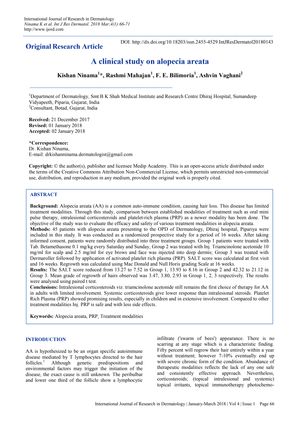A Clinical Study on Alopecia Areata
January 2018
in “
International journal of research in dermatology
”

TLDR Intralesional corticosteroids are the best for limited alopecia areata, oral steroids are less effective, and PRP is safe and promising, especially for children and severe cases.
In a clinical study conducted on 45 patients with alopecia areata (AA), three treatment modalities were compared: oral mini pulse therapy with betamethasone, intralesional corticosteroids with triamcinolone acetonide, and platelet-rich plasma (PRP) therapy. The study was randomized and prospective, lasting 16 weeks. Results showed a reduction in the Severity of Alopecia Tool (SALT) score for all groups, with the scores decreasing from 13.27 to 7.52 in Group 1, 13.93 to 8.16 in Group 2, and 42.32 to 21.12 in Group 3. The mean grade of hair regrowth was 3.47 for Group 1, 3.80 for Group 2, and 2.93 for Group 3. The study concluded that intralesional corticosteroids remain the first choice of therapy for adults with limited AA, systemic corticosteroids are less effective than intralesional steroids, and PRP showed promising results, particularly in children and cases with extensive involvement, being safe and with fewer side effects.
